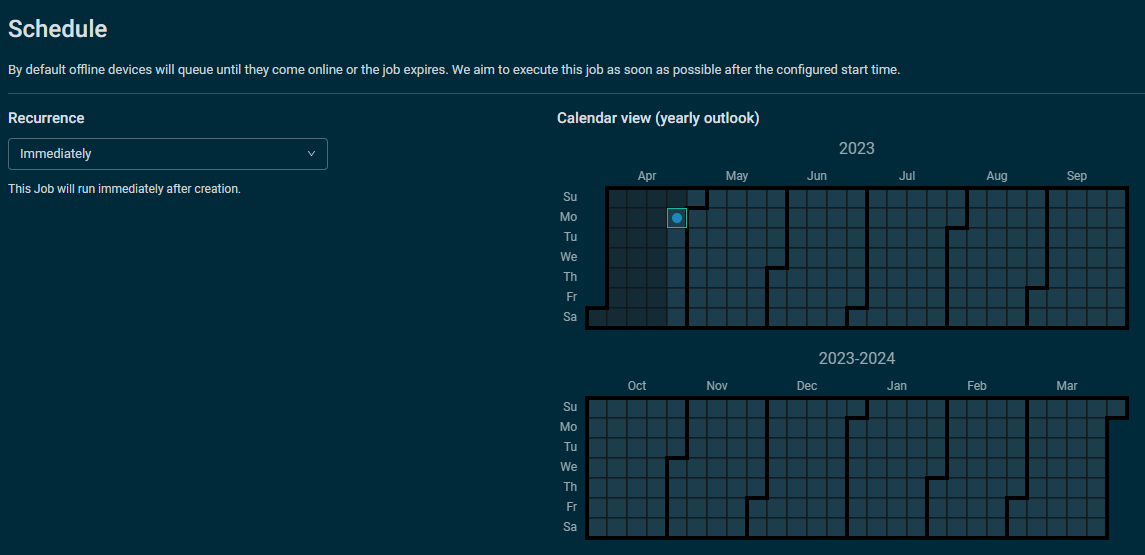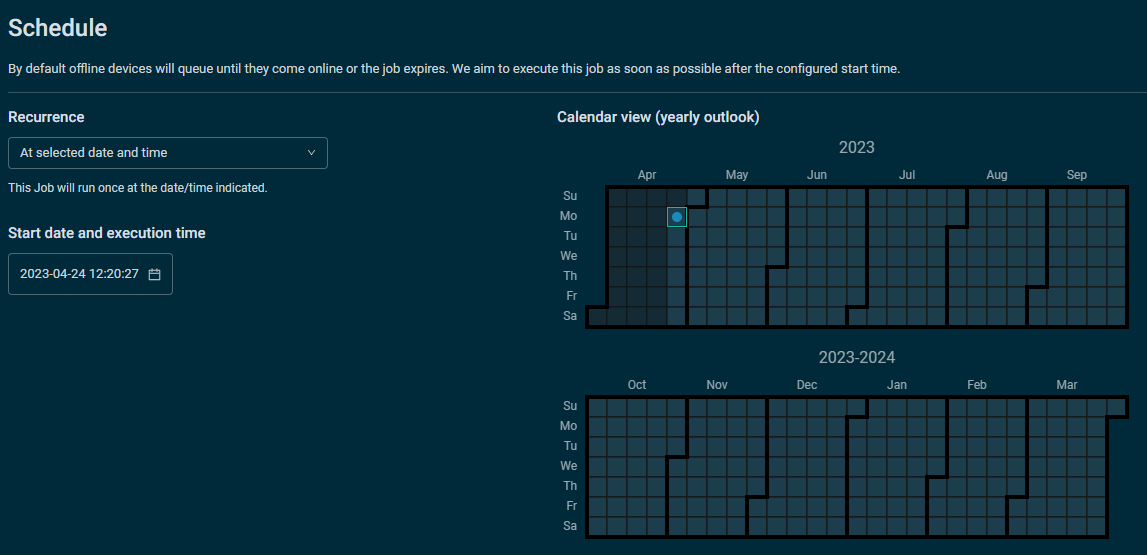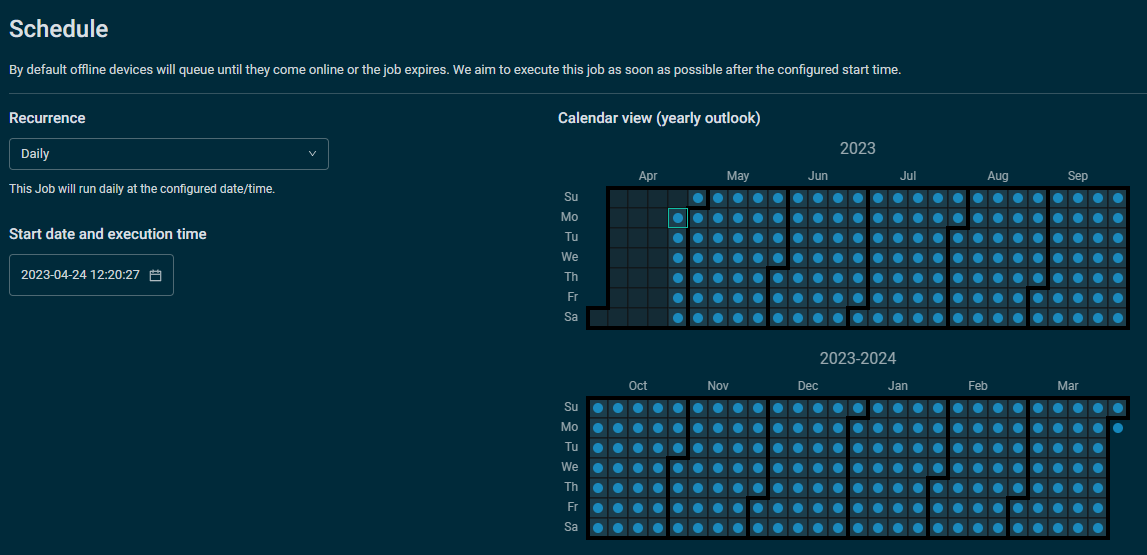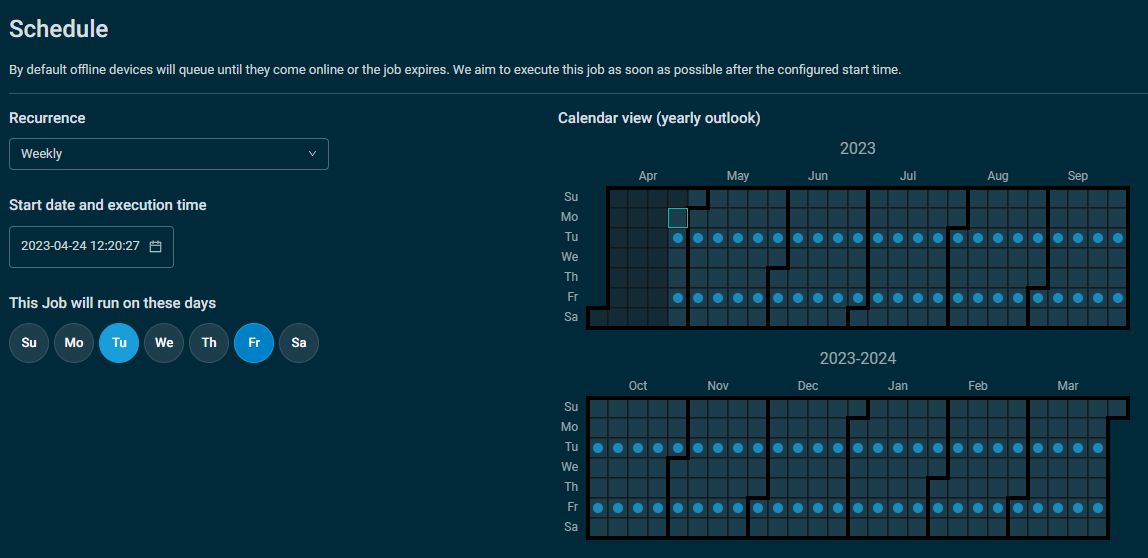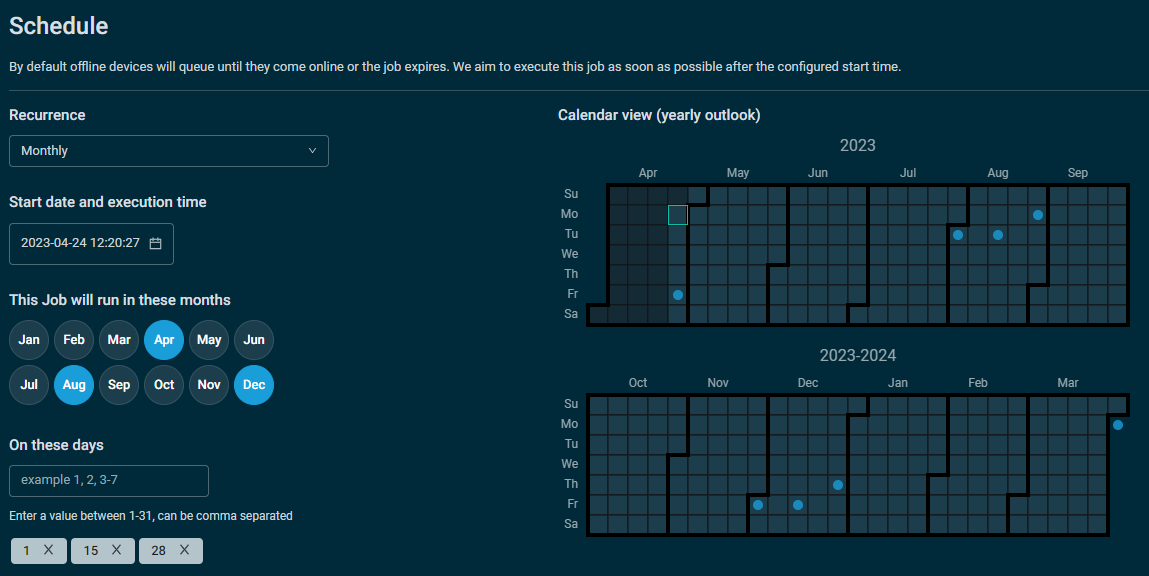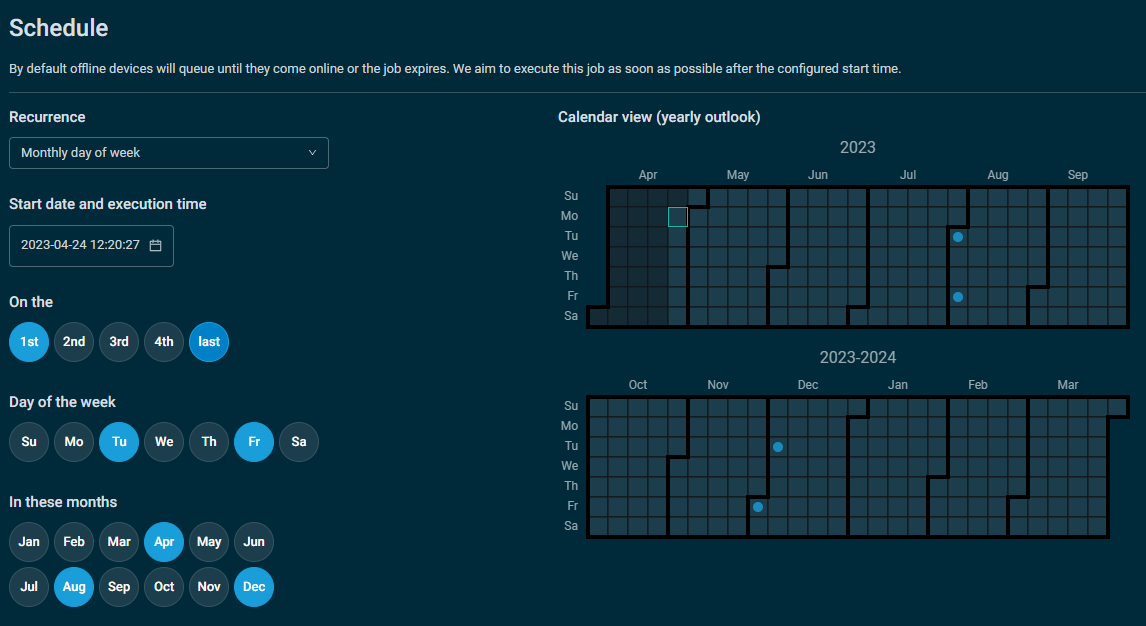Scheduled jobs
PERMISSIONS Refer to Jobs > Active Jobs in Permissions.
NAVIGATION Automation > Jobs > Create Job
NAVIGATION Job results page > select one or more devices (check boxes) > Create a Job. To view the various navigation paths you can use to access the job results page, refer to Job results.
NAVIGATION Automation > Components > hover over the Edit drop-down menu for a component > Create a Job
NAVIGATION Sites > All Sites > click the name of a site > select one or more devices (check boxes) > Create a Job
NAVIGATION Devices > All > select one or more devices (check boxes) > Create a Job
NAVIGATION Device summary page > click the More icon > Create a Job. To learn how to access the device summary page, refer to Device summary.
NAVIGATION A targeted list of devices > select one or more devices (check boxes) > Create a Job. To view the navigation paths for the various targeted lists of devices, refer to Targeted lists of devices in Devices.
NAVIGATION List of alerts > select one or more alerts (check boxes) > Create a Job. To view the navigation paths for the various lists of alerts, refer to Alerts.
NAVIGATION Automation > Jobs > Edit Job (Action column in table)
NAVIGATION Automation > Jobs > click the name of a job > Edit Job
About
A job is an automated process for deploying one or more components to a number of devices, either immediately or at a scheduled time. When a job runs, the Agent downloads the job to the local hard drive of the device or devices, unpacks the package into its component parts, and runs the script. Jobs can be scheduled for individual devices, sites, filters, or groups. The following device types support running jobs:
- Servers
- Laptops
- Desktops
Components must first be downloaded from the ComStore into your Component Library. Refer to ComStore. Components can only be added from the ComStore if you have Manage access to ComStore. Refer to ComStore in Security levels.
NOTE A quick job allows you to immediately deploy one component without having to schedule the job. Refer to Quick jobs.
Creating a job
To create a job, follow any of the navigation paths described in Creating a job in Security and navigation.
Enter a name for the job.
Click Add Component to open a pane to the right.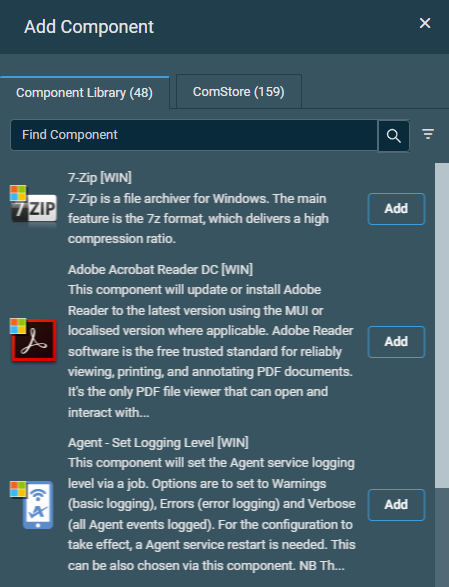
The tab selection will persist the next time the pane is accessed.
You may filter components by component group or category using the filter icon ![]() , or you may search for components using the search bar. The search results will be narrowed as you type. For more information about component categories, refer to List of components. You will only be able to see the components available to you based on your component level. Refer to Component Level.
, or you may search for components using the search bar. The search results will be narrowed as you type. For more information about component categories, refer to List of components. You will only be able to see the components available to you based on your component level. Refer to Component Level.
Within the Component Library tab, click Add to add a component to the job. All components of the categories Applications and Scripts are available for jobs. Refer to List of components. You may also add a component from the ComStore to your job. Within the ComStore tab, click Add. The component will be automatically added to your Component Library as well as to your job. Components that have already been added to your Component Library will appear as grayed out. Hovering over the grayed out component will display a tooltip that allows you to click to navigate to the downloaded component within your Component Library.
Once the component has been added, click X to close the pane and return to the Create a Job page. You can then configure any required variables for the component.
Variable value limit: 20,000 characters. 
You may also add or remove components. Components will be executed sequentially in the order in which they are added. You can change this order by dragging and dropping the components on the page in the order in which you want them to run.
IMPORTANT Because job results are rate limited to 30 component results per hour, It is recommended that you add at most 30 components to a single job to avoid issues with reporting back job results to Datto RMM.
Click Add Target to open the Targets pane. Click Add to add the selected target or Delete to remove it. When creating and scheduling a job from a device's page or a devices table, the selected target will automatically be populated in this section.
You may filter on the following target types:
| Target Type | Description |
|---|---|
| Device Filters | You can select any of the Default Device Filters provided by Datto RMM, as well as Custom Device Filters and Site Device Filters. Refer to Device filters.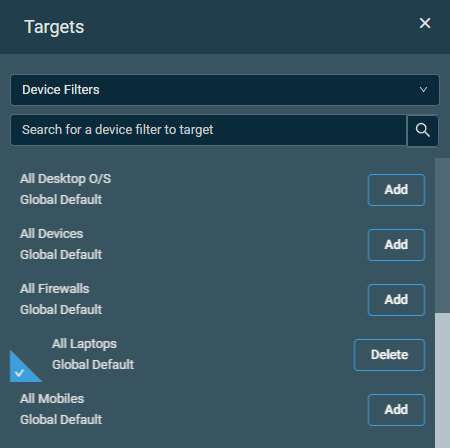 When you choose a Default Device Filter, you can edit the sites by clicking the pencil icon on the Create a Job page.  Within the Filter by Site(s) pane, toggle the All Sites button off to only select certain sites instead of all sites. You may also search for sites using the search bar. These changes will be reflected on the Create a Job page. If specific sites are selected, hover over the number of sites to see which sites have been selected for this device filter.  |
| Device Groups | You can select Device Groups and Site Device Groups. Refer to Groups. |
| Site Groups | Refer to Site Groups.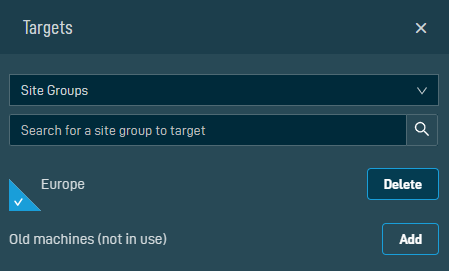 |
| Sites | Refer to Sites.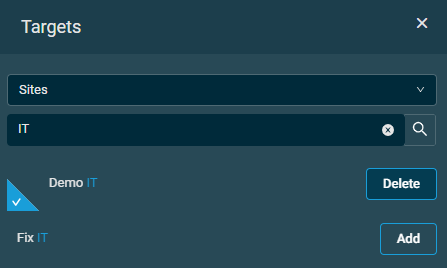 |
| Devices | Refer to Devices.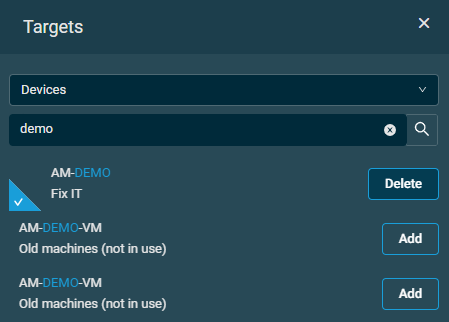 |
You may also search for targets using the search bar. A check in the corner next to a target indicates that it has already been added to the job. Click X to close the Targets pane and to return to the Create a Job page. 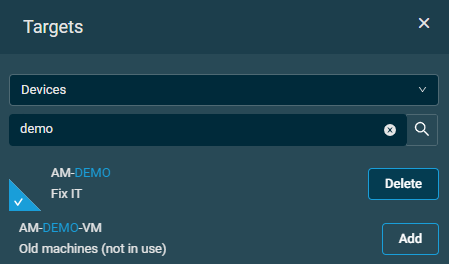
A scheduled job allows you to run one or more components immediately or at a scheduled time. Select an option from the Recurrence drop-down menu to schedule your job. The calendar view will provide a visual indicator of when the job will run according to the selected schedule.
The creator of the job configures the schedule according to their user time zone configured on the Setup > My Settings page. The job will run at the respective time in all users' time zones. Refer to User Time Zone.
NOTE If multiple jobs are triggered against a device at the same time, either because they were scheduled at the same time or because the device became available during multiple job durations, there is no way to choose the order in which they run. Therefore, if you need to run multiple components in a specific order, it is recommended that you place them all in the same job in the order you wish them to run.
NOTE Scheduled jobs pending for more than six months will be deleted. Devices that are offline for six months or longer and targeted by these jobs will not receive them if and when they come back online. Any scheduled job set to disabled is excluded from deletion.
The following options are available:
Duration
To define when a recurring job should no longer be available for scheduling, click the Duration toggle and select a date and time from the calendar. After this date has passed, this job will no longer be automatically rescheduled.
Expiration
Select when the job will expire from the Expiration drop-down menu. Expiration defines the length of time the scheduled job remains available as either a queued or a running job. After this time has elapsed, the expired job will be canceled (if running) or removed from the job queue until the next scheduled time. This field cannot be configured for Initial Audit jobs.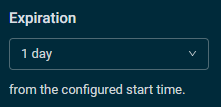
The following options are available:
- Does not expire
- 30 mins
- 1 hr
- 2 hrs
- 4 hrs
- 8 hrs
- 12 hrs
- 1 day
- 3 days
NOTE The duration setting works independently from the expiration setting and will therefore not prevent a correctly scheduled job from running.
These options allow you to configure email notifications pertaining to the job and to specify recipients of the notifications.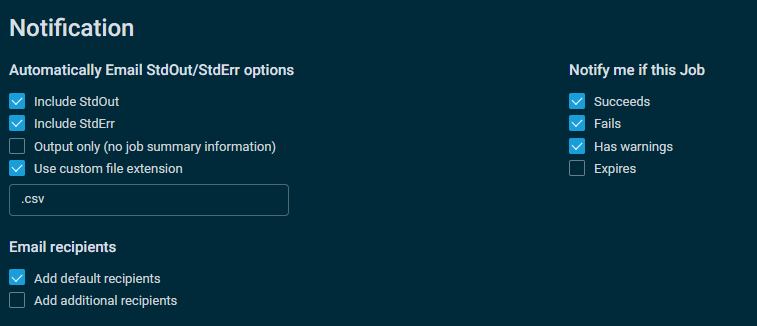
The following options are available:
| Field | Description |
|---|---|
| Automatically Email StdOut/StdErr Options | Configure export options for StdOut (standard output) and StdErr (standard error) messages:
|
| Notify Me If This Job | Configure notifications to be sent via email when the job does any of the following:
|
| Email Recipients | Specify the users who will receive the email notifications you have configured: IMPORTANT You must select at least one of the Automatically Email StdOut/StdErr options and at least one Notify me if this Job option to be able to configure this section.
Click the plus icon to add an additional recipient. Click the minus icon next to any configured recipient to remove that recipient. NOTE The email field accepts the following characters: |
These options allow you to run the job automatically or with user interaction.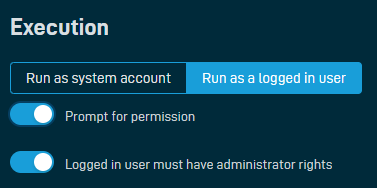
Choose from the following options:
- Run as system account: Select to run this job automatically without user interaction.
- Run as a logged in user: Select to run this job automatically only when the user is logged in. Once selected, the following additional options become available:
- Prompt for permission: Toggle to prompt the user to run the job.
- Logged in user must have administrator rights: Toggle if the end user must be an Administrator of the device in order for the job to run.
NOTE Jobs with Run as a logged in user selected will not run on devices running Datto RMM in Service-only mode.
When you are finished, click Create Job to execute the action or Cancel to discard the new job progress and return to the Jobs page.
NOTE The Name, Components, and Targets fields are required for the Create Job button to become available.
A dialog box will confirm whether you wish to create this job. Click Confirm to execute the action or Cancel to close out of the dialog box. A confirmation dialog box will confirm that the job has been created successfully.
Editing a job
NOTE Only jobs with the Active status can be edited.
Follow any of the navigation paths described in Editing a job. On the Edit a Job page, complete the sections below to modify an existing job. You may also delete the job by clicking Delete, retire the job by clicking Retire, or copy the job by clicking Copy at the top of the page.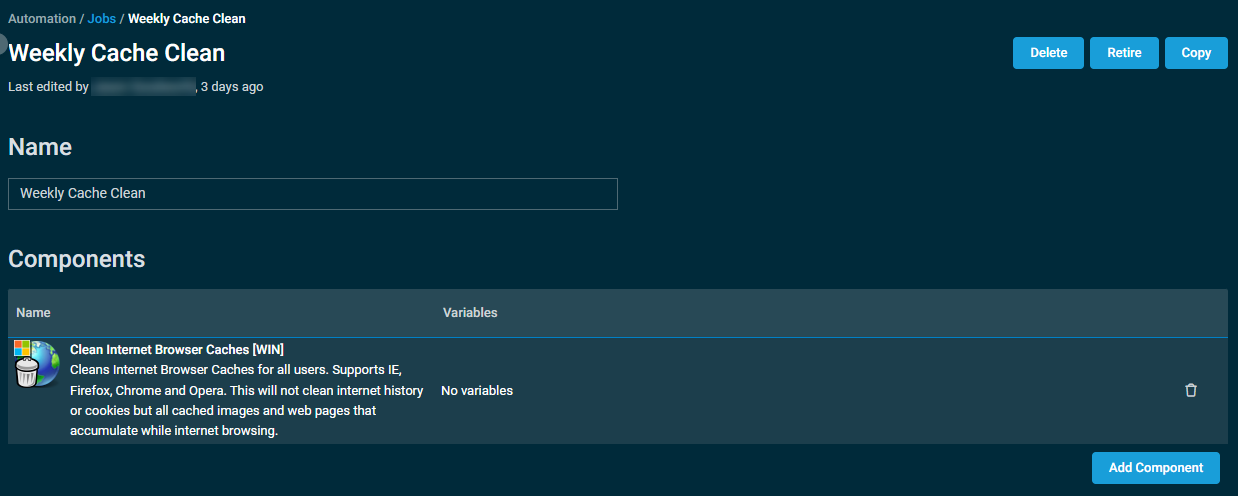
IMPORTANT A job can only be viewed, edited, copied, deleted, or retired by users with the Administrator security level or a user with the same security level as the one that was used when the job was created. For example, if a job was created by a user with the Administrator security level, non-administrator users will be unable to view, edit, copy, delete, or retire that job.
| Field | Description |
|---|---|
| Name | Change the name of the job. Refer to Name. NOTE An edited job name appears on the job results page after the next job is run. Refer to Job results. For existing Initial Audit jobs, name edits are not reflected. |
| Components | Add, remove, or change the order of components the job will run. Refer to Components. |
| Targets | Add or remove targets the job will run against. Refer to Targets. |
| Schedule | Configure a schedule for the job. Refer to Schedule. |
| Notification | Configure email notifications for the job. Refer to Notification. |
| Execution | Choose how to run the job. Refer to Execution. |
| Enabled/Disabled | Enable or disable the job. |
| Save the Job | When you are finished, click Save to save the changes to the job, or select Cancel to discard the changes. A dialog box will confirm whether you are sure you wish to edit this job. Click OK to save your changes. A dialog box will confirm that the changes have been saved successfully. Otherwise, click Cancel. |
Viewing job details
Jobs and their statuses can be viewed from the Jobs page. Refer to Jobs overview. They are also displayed in the Activities card on the device summary page. Refer to Activities.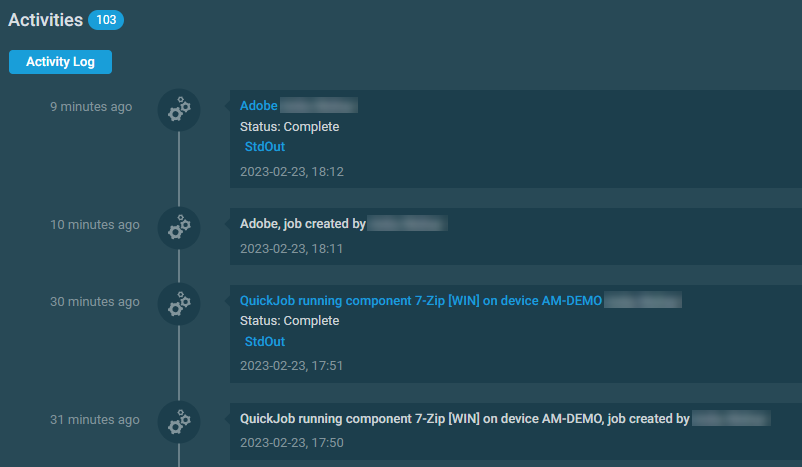
Click a hyperlinked job name to be directed to the job results page. Refer to Job results.
